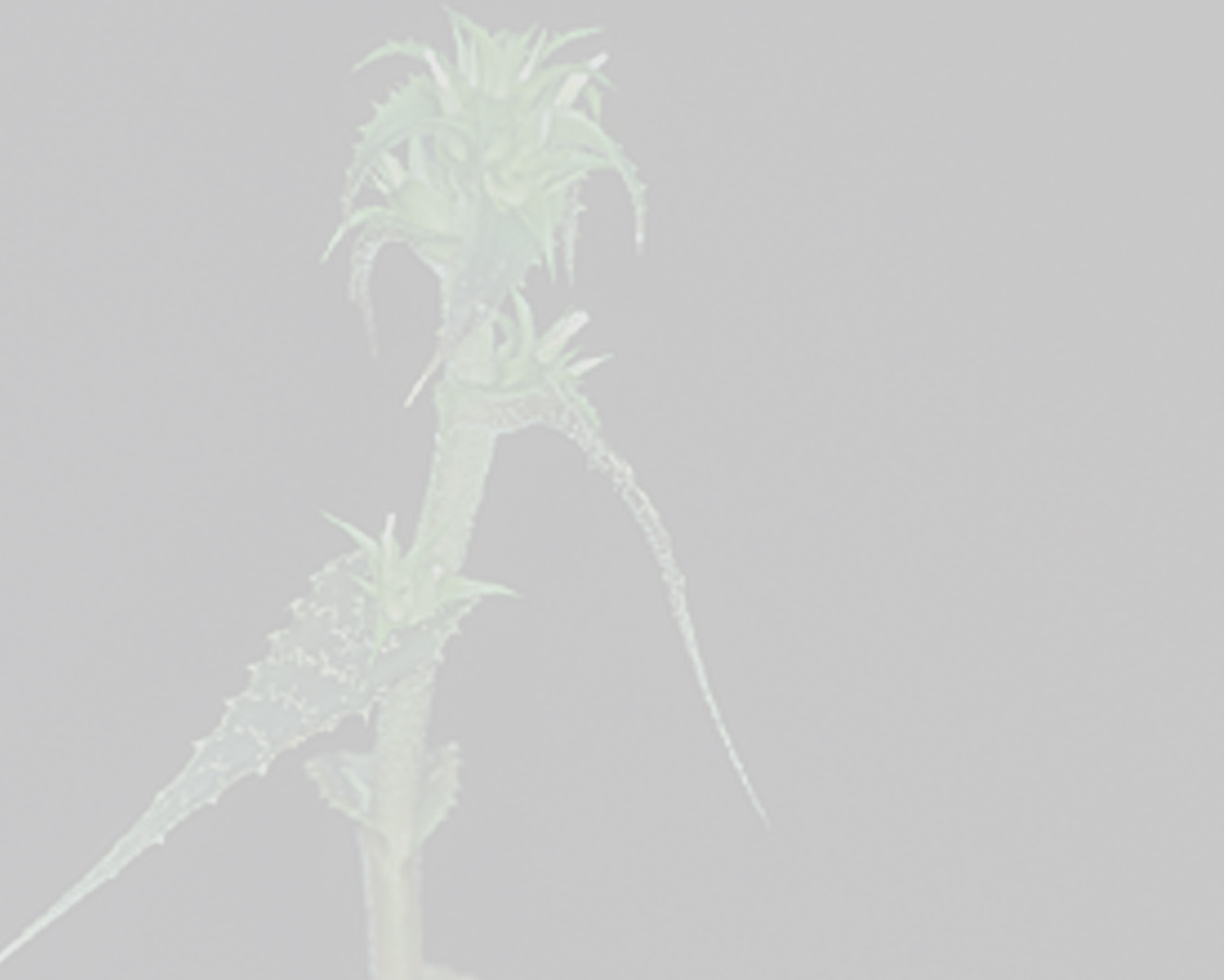


plant saxicolous, long caulescent, stem 20–57 cm long, 0.8–1 cm in diameter, propagating by 1–2 short shoots produced at the base of the inflorescence. leaves densely and equally arranged along the stem, spreading; sheath inconspicuous, subtrapeziform, 1–1.3 × 1.8–2 cm, greenish toward distal end, winish to hyaline toward the base, thin in texture, densely white lepidote and densely spinulose near the apex, glabrous and entire toward the base, densely and conspicuously nerved; blade very narrowly triangular, 5–11 cm long, 0.8–1.3 cm wide at the base, coriaceous, channeled with upright margins mainly under water stress, densely and coarsely white lepidote on both sides, green but the color completely obscured by the trichomes, abaxially nerved, apex attenuate, not pungent, margins densely spinulose; spines subtriangular, straight to prevailingly antrorse-uncinate, reddish, 0.5–1 mm long, 0.3–0.5 mm wide at the base, 1.5–4 mm apart. inflorescence sessile, corymbose, 3–4 cm long, fasciculate compound at the base and unbranched toward the apex; primary bracts foliaceous, gradually reduced in length toward the apex of the inflorescence but distinctly exceeding the fascicles; fascicles 9–12 in number, densely disposed, nearly sessile, flabellate, slightly pulvinate, 17–18 mm long (excluding the petals), 0.8–14 mm wide, 3–7-flowered; floral bracts in the fascicles narrowly triangular, acute to acuminate, 10–12 × 4–8 mm, distinctly carinate, about equaling the midpoint of the sepals, greenish to wine colored, nerved, densely and coarsely white lepidote, thin in texture, not pungent, margins entire; floral bracts* of the apical unbranched part of the inflorescence subfoliaceous, equaling to exceeding the flowers. flowers 1.9–2.4 cm long, sessile, densely arranged, distinctly fragrant; sepals narrowly lanceolate, apex acuminate, 9–10 × 2.5–3 mm, free, entire, greenish except for the winish colored margins, thin in texture, not pungent, coarsely white lepidote, obtusely carinate to carinate with keels continuating on the ovary; petals lanceolate to narrowly obovate, acute to inconspicuously emarginate, 15–18 × 4.5–5 mm, free, subspreading-recurved, lilac-rose, naked but bearing 2 conspicuous longitudinal callosities about equaling the antepetalous filaments; callosities inconspicuously glandulose at the base. stamens: filament terete, the antepetalous ones 5–6 mm long, the antesepalous ones 8–9 mm long; anther 2.5–3 mm long, base distinctly bilobed, apex obtuse, dorsifixed at 1/4–1/3 from the base, the antesepalous ones exceeding the antepetalous ones by its whole length and nearly equaling the stigma; pollen spheroidal or nearly so, ca 45 μm, sulcate, sulcus narrow, not covered by exine elements, with margins weakly defined, exine reticulate, muri narrow. pistil rose-lilac for most of its length; ovary obovoid, trigonous, 4–6 × 3–4 mm, whitish, coarsely white lepidote; stigma simple-erect with tendency to conduplicate-patent, lobes spreading, short to elongate, 0.7–1 mm long, rose-lilac toward the base and white near the apex, margins inconspicuously crenulate, without papillae; placentation apical; ovules few, obtuse; epigynous tube inconspicuous. fruits globose, greenish, 4–7 × 3.5–6 mm, calyx persistent, paleaceous; seeds 3 to 5 per fruit, 2.2–3 × 1–2 mm.Edited from (28-04-2015): Leme 2015a. Two new species of Orthophytum (Bromeliaceae: Bromelioideae) from Minas Gerais, Brazil .